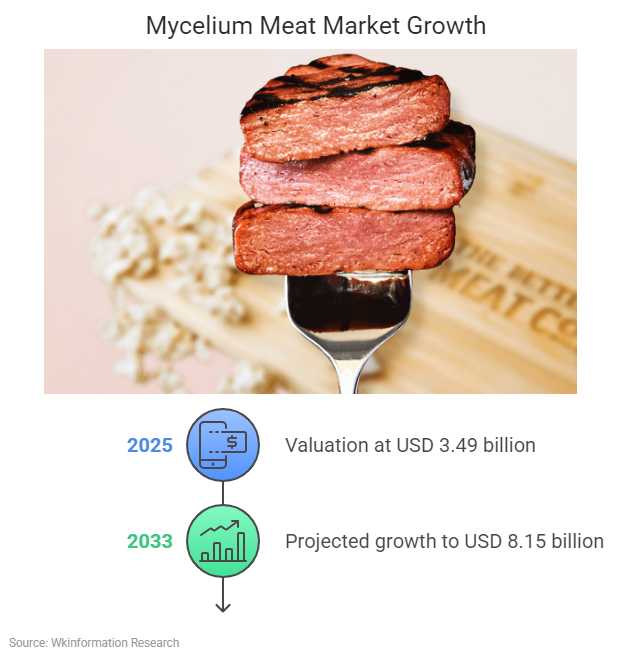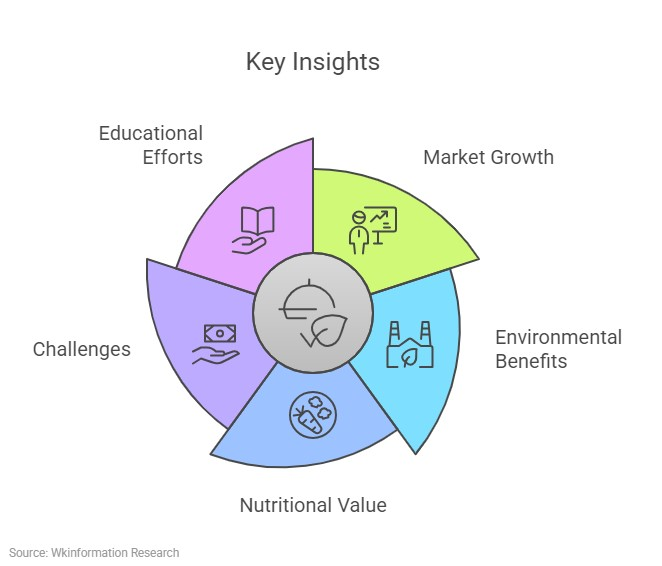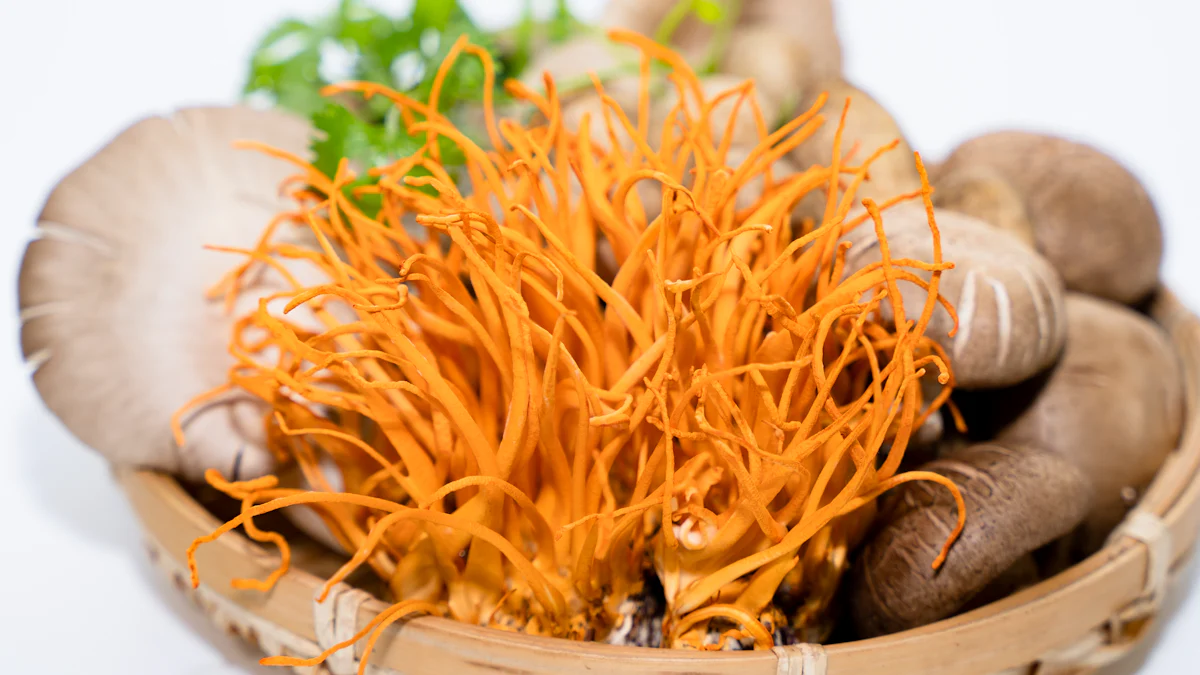
The global mycelium meat market has emerged as a transformative force in the food industry. Valued at USD 3.49 billion in 2025, it is projected to reach USD 8.15 billion by 2033, growing at a CAGR of 11.18%. Mycelium-based meat addresses critical challenges in traditional meat production, such as zoonotic disease risks and high environmental costs. Its production requires fewer resources like land and water while emitting significantly less greenhouse gases. By eliminating animals from the process, mycelium offers a sustainable and efficient protein alternative that aligns with evolving consumer preferences.
Key Insights
- The global mycelium meat market is growing fast. It may reach USD 8.15 billion by 2033 due to demand for eco-friendly protein.
- Making mycelium meat uses fewer resources and less carbon. This makes it a better choice for the planet.
- Health-focused people like mycelium meat for its good nutrition. It is low in fat and cholesterol but has important nutrients.
- There are problems like high costs and strict rules. But new fermentation methods are making production better.
- Teaching people about mycelium meat is important. It helps them trust its safety, taste, and benefits for the environment.

Market Overview
Market Size and Growth Rate
Current valuation and projected growth of the mycelium meat market.
The global mycelium meat market is witnessing remarkable growth, driven by increasing demand for sustainable protein sources. Valued at USD 3.49 billion in 2025, the market is projected to grow at a compound annual growth rate (CAGR) of 11.18%, reaching USD 8.15 billion by 2033. This growth reflects the rising consumer interest in meat alternatives and the adoption of innovative food technologies.
Regional performance and key markets driving growth.
Europe leads the adoption and production of mycelium-based meat products, supported by significant investments in research and development. Companies like Mycorena and Quorn Foods, along with startups such as Meati Foods, are driving innovation in this region. North America also plays a crucial role, with growing consumer awareness of sustainability and health benefits fueling demand. These regions are setting benchmarks for the global expansion of mycelium-based products.
Key Market Drivers
Rising demand for sustainable and eco-friendly food options.
Consumers increasingly prioritize sustainability in their purchasing decisions. Surveys reveal that 57% of Americans consider leading a sustainable lifestyle important, while 52% want to understand the environmental impact of their food choices. Actions like recycling and reducing food waste, each practiced by 60% of consumers, highlight this shift. Mycelium production aligns with these values by using fewer resources and emitting less carbon compared to traditional meat.
Increasing consumer awareness of health and environmental benefits.
Health-conscious consumers are drawn to mycelium-based proteins for their nutritional advantages. These products are low in fat, cholesterol-free, and rich in nutrients, making them a healthier alternative to traditional and plant-based meat. Additionally, the environmental benefits of mycelium, such as reduced water and land usage, resonate with eco-conscious buyers. The shift toward plant-based diets further accelerates the growth of the mycelium meat market.
Challenges in Market Expansion
High production costs and scalability issues.
Scaling mycelium production to meet rising demand presents significant challenges. Technological complexities, such as managing shear stress and oxygen availability, hinder large-scale production. Specialized facilities are required, increasing costs. For instance, Mycorena discontinued its large-scale factory project in Sweden due to scalability issues. Companies like Keen 4 Greens are addressing these challenges by adopting smaller bioreactor farms, which reduce contamination risks and improve efficiency.
Regulatory hurdles and consumer skepticism.
The regulatory landscape poses another barrier to market expansion. The approval process for novel foods, including mycoprotein-based products, is often lengthy and expensive. Smaller companies face difficulties navigating these requirements, delaying market entry. Additionally, some consumers remain skeptical about the safety and taste of mycelium-based meat, necessitating educational efforts to build trust and acceptance.
Key Trends in the Mycelium Meat Market

Innovation in Mycelium-Based Products
Development of new textures and flavors to mimic traditional meat.
The development of textures and flavors that closely resemble traditional meat has become a focal point for companies in the mycelium meat market. Products like mycelium-based burgers and meatballs demonstrate this innovation. For instance, mycelium-based burgers offer a rich umami profile tailored to regional tastes, such as those in Korea. Similarly, mycelium-based meatballs combine mycelium with mushrooms and other plant-based ingredients to cater to diverse consumer preferences.
Use of advanced fermentation technologies to enhance production.
Advanced fermentation technologies are revolutionizing the production of mycelium-based meat. These technologies enable precise control over cultivation conditions, ensuring optimal growth of mycelium. They also facilitate scalability, allowing companies to transition from small-scale to industrial production. Additionally, fermentation reduces resource usage, making it a sustainable alternative to traditional farming. Customizable fermenters further promote diverse product development by accommodating different fungi strains.
- Advanced fermentation technologies enable precise control over cultivation conditions, ensuring optimal growth of mycelium.
- These technologies facilitate scalability, allowing for a transition from small-scale to industrial production.
- Sustainability is enhanced as fermenters reduce resource usage compared to traditional farming methods.
- Customizable designs of modern fermenters cater to different fungi strains, promoting diverse product development.
Sustainability and Environmental Impact
Reduced carbon footprint compared to traditional meat production.
Mycelium-based meat production significantly reduces its carbon footprint compared to traditional meat production. It requires only 1% of the resources used in conventional livestock farming. Minimal water, energy, and land are needed, and vertical cultivation methods make it suitable for urban agriculture. These efficiencies align with global efforts to combat climate change and promote sustainability in food systems.
Efficient use of resources like water and land.
The resource efficiency of mycelium production is unparalleled. Unlike traditional farming, which demands vast amounts of water and land, mycelium can thrive in controlled environments with minimal inputs. This efficiency not only reduces environmental strain but also makes mycelium-based meat a viable option for regions with limited agricultural resources.
Clean-Label and Health-Focused Demand
Preference for minimally processed, natural ingredients.
Consumers increasingly prefer minimally processed foods with natural ingredients. Reports indicate that 34% of consumers avoid artificial ingredients, while 26% seek products without additives. This trend has driven demand for mycelium-based meat, which offers clean-label options free from artificial components. Such preferences reflect a growing awareness of food processing and its impact on health and sustainability.
Nutritional benefits of mycelium-based proteins.
Mycelium-based proteins provide numerous nutritional benefits. They contain all nine essential amino acids with high bioavailability, making them a complete protein source. Additionally, they are rich in fiber, vitamins, and nutrients while being low in cholesterol and saturated fats. These attributes promote muscle synthesis, improve satiety, and positively impact blood lipids, insulin, and glucose levels, making mycelium a superior alternative to both plant-based meat and traditional meat.
Industry Analysis
Major Players in the Mycelium Meat Market
Overview of leading companies like Beyond Meat and startups innovating in the space.
The mycelium meat market features several prominent players driving innovation and growth. Established companies like Quorn Foods have long been recognized for their expertise in mycoprotein production, continuously enhancing consumer acceptance through marketing and product development. Startups such as Meati Foods focus on whole-cut mycelium products, diversifying the market with unique offerings. Mycorena, known for its Promyc® protein, was recently acquired by Naplasol/VEOS, highlighting the strategic importance of mycelium-based solutions. Naplasol aims to expand production capabilities in Belgium, further strengthening its position in the alternative protein sector.
Key partnerships and collaborations driving product development.
Collaborations play a pivotal role in advancing the mycelium meat market. Strategic partnerships enable companies to pool resources and expertise, enhancing their competitive edge. Startups often partner with established food companies to access distribution networks and scale production. Government initiatives, such as the EU Green Deal, foster public-private partnerships, providing funding and research opportunities. These collaborations accelerate innovation and facilitate the integration of mycelium-based products into mainstream markets.
| Evidence | Description |
|---|---|
| Strategic partnerships and acquisitions | Enable companies to combine resources, expertise, and market access to enhance competitive advantage. |
| Partnering with established food companies | Provides startups with necessary resources and distribution networks to scale production and reach mainstream markets. |
| Government initiatives and funding programs | Present opportunities for public-private partnerships to access funding, research facilities, and expertise. |
Funding and Investment Trends
Recent funding rounds and venture capital interest in mycelium-based meat.
The mycelium-based meat industry has attracted significant investments, reflecting growing consumer interest in sustainable food options. For instance, Mycorena secured €24 million in Series A funding in 2022, underscoring investor confidence in the sector. Both private equity and public funding initiatives, such as the EU Green Deal, support innovation in sustainable food systems. These investments aim to enhance production capabilities and bring mycelium-based products closer to price parity with traditional proteins.
Government and private sector support for alternative proteins.
Governments and private sectors actively promote the development of alternative proteins like mycelium. Initiatives such as the EU Green Deal and Horizon Europe provide funding opportunities for sustainable food technologies. Public-private partnerships allow companies to access research facilities and expertise, while collaborations with government agencies help navigate regulatory challenges. These efforts aim to accelerate the adoption of mycelium-based meat and other innovative protein sources.
- Government initiatives and funding programs promote sustainable food production.
- Opportunities for public-private partnerships allow investors to access funding and expertise.
- Collaborations with government agencies help navigate regulatory challenges.
Scalability and Production Challenges
Barriers to large-scale production and distribution.
Scaling up mycelium production presents several challenges. Submerged fermentation processes face technical issues like shear stress and oxygen availability, complicating large-scale operations. Solid-state fermentation, while promising, lacks scalable contract manufacturing options, creating hurdles for startups. Regulatory approval processes for novel foods also require significant investment in research and documentation, delaying market entry for smaller companies.
Despite growing interest, alternative proteins still face challenges in gaining widespread consumer acceptance. Education about the environmental and health benefits of mycoprotein products is essential to increase market penetration.
Innovations addressing cost and efficiency issues.
Innovations in fermentation and bioprocessing technologies aim to overcome scalability and cost barriers. Companies like Meati Foods leverage the exponential growth potential of fungi, producing a cow’s worth of protein in just four days. These advancements reduce production costs and improve efficiency, making mycelium-based proteins more competitive with traditional meat.
- Mycelium brands are working towards price parity and affordability due to the naturally exponential potential of fungi.
- Innovations in fermentation and bioprocessing technologies are expected to improve the efficiency and scalability of mycelium production.
Consumer Insights
Health Benefits and Nutritional Value
High protein content and low environmental impact of mycelium-based meat.
Mycelium-based meat offers a high-quality protein source with a minimal environmental footprint. It contains all nine essential amino acids, making it a complete protein. Additionally, it is rich in fiber and vitamins while being low in cholesterol and saturated fats. These attributes make it an ideal choice for health-conscious consumers seeking sustainable alternatives. Unlike traditional livestock farming, mycelium production requires significantly fewer resources, such as water and land, and emits lower greenhouse gases, aligning with the current consumer trend toward eco-friendly food options.
Taste and Texture Preferences
Consumer feedback on taste and texture improvements.
Consumers often evaluate meat alternatives based on taste and texture. Mycelium-based products have made significant strides in replicating the sensory experience of traditional meat. Feedback highlights improvements in juiciness, mouthfeel, and flavor. However, concerns about unnaturalness and safety persist, which can hinder acceptance. Addressing these perceptions through education and transparent marketing remains crucial.
Importance of replicating the sensory experience of meat.
Replicating the sensory attributes of traditional meat is vital for consumer acceptance. Mycelium-based products excel in mimicking the juiciness, texture, and flavors of conventional meat. These qualities enhance their appeal to mainstream consumers, particularly those transitioning from animal-based proteins. A focus on culinary innovation further strengthens their position in the market.
Adoption Rates and Market Penetration
Demographics driving demand for mycelium meat.
Health-conscious individuals and environmentally aware consumers drive the demand for mycelium-based meat. In Europe, the emphasis on wellness and sustainability has spurred interest in low-fat, cholesterol-free protein sources. Younger demographics, particularly Millennials and Gen Z, also show a strong preference for innovative and eco-friendly food options.
Regional differences in consumer acceptance.
Consumer acceptance varies across regions. Europe and North America lead the adoption of mycelium-based products due to higher awareness of sustainability and health benefits. In contrast, regions with limited exposure to alternative proteins may require targeted education and marketing efforts to foster acceptance.
Note: Effective marketing strategies and consumer education are essential to overcoming skepticism and expanding the mycelium meat market globally.
Future Outlook

Growth Opportunities
Expansion into new markets and regions.
The mycelium meat market holds significant potential for expansion into untapped regions and industries. European companies, leveraging their expertise, can form strategic partnerships with global food companies to access new consumer bases. Emerging markets in Latin America, Africa, and Southeast Asia present promising opportunities due to their growing interest in sustainable food solutions. Companies can develop culturally relevant mycelium-based products to cater to these regions. Beyond food, mycelium offers applications in packaging, textiles, and construction, contributing to a circular economy.
| Growth Opportunity | Description |
|---|---|
| Expansion into New Markets | European companies can leverage their expertise to enter international markets, forming strategic partnerships with global food companies to access new consumer bases. |
| Targeting Emerging Markets | Emerging markets in Latin America, Africa, and Southeast Asia are interested in sustainable food solutions, providing opportunities for companies to develop culturally relevant mycelium-based products. |
| Diversifying Applications Beyond Food | Mycelium can be used in packaging, textiles, and construction, offering unique investment opportunities in biodegradable packaging and sustainable materials, contributing to a circular economy. |
Potential for integration into mainstream food products.
Integrating mycelium-based meat into mainstream food products requires strategic efforts. Educating consumers about its benefits as a sustainable protein source is essential. Technological advancements in fermentation and bioprocessing will enhance efficiency and scalability, reducing production costs. Collaborations with established food companies can provide the resources and distribution networks needed to reach broader markets. For example, Infinite Roots partnered with Pulmuone to launch mycelium-based products tailored to Korean tastes, demonstrating how localization can boost acceptance.
- Consumer Awareness and Acceptance: Educating consumers about the benefits of mycelium as a sustainable protein source is essential for increasing market penetration.
- Technological Advancements: Innovations in fermentation and bioprocessing technologies will improve efficiency and scalability, lowering production costs and enhancing product quality.
- Strategic Partnerships: Collaborations with established food companies can provide necessary resources and distribution networks to scale production and reach mainstream markets.
Challenges to Overcome
Addressing consumer misconceptions and education.
Consumer skepticism about the safety and taste of mycelium-based meat remains a challenge. Many individuals perceive alternative protein products as unnatural. Companies must invest in transparent marketing and educational campaigns to address these misconceptions. Highlighting the nutritional benefits and environmental advantages of mycelium can build trust and encourage adoption.
Balancing cost reduction with product quality.
Achieving price parity with traditional meat while maintaining quality is critical for market growth. Innovations in fermentation and bioprocessing technologies can reduce production costs. However, companies must ensure that cost-cutting measures do not compromise the taste, texture, or nutritional value of their products. Striking this balance will be key to long-term success.
Emerging Innovations
Use of AI and biotechnology in product development.
Advancements in AI and biotechnology are transforming mycelium-based food production. Functional genomics enables the identification and improvement of fungi strains, enhancing taste and nutritional value. Companies like Kynda utilize submerged biomass fermentation to efficiently produce mycelium protein using food industry byproducts. This method accelerates production and improves the nutritional profile of the final product. Additionally, Revo Foods employs 3D structuring technology to replicate meat muscle structures, enhancing the sensory experience of mycelium-based seafood alternatives.
Potential for hybrid products combining mycelium with other proteins.
Hybrid products combining mycelium with other proteins offer exciting possibilities. These products diversify diets and improve nutritional profiles while reducing the environmental impact of traditional meat production. The versatility of mycelium allows for the creation of innovative products, including dairy and seafood substitutes. Familiarity with popular plant-based proteins can ease consumer adoption of hybrid products, expanding market reach and catering to diverse preferences.
- Hybrid products combining mycelium with other proteins can diversify diets and improve nutritional profiles.
- These products have the potential to reduce environmental impacts associated with traditional meat production.
- Familiarity with popular plant-based proteins like mycelium can ease consumer adoption of hybrid products.
Overview
The mycelium meat market continues to gain momentum, fueled by strong demand for sustainable and animal-free proteins. Its ability to address environmental concerns while meeting consumer preferences positions it as a transformative force in the food industry. Despite challenges like scalability and consumer education, the market’s potential remains immense. Companies investing in innovation and production efficiency will shape the future of this sector. Sustainability and technological advancements will play pivotal roles in unlocking the full potential of mycelium-based products.
| Report Metric | Details |
|---|---|
| Report Name | Global Mycelium Meat Market Report |
| Base Year | 2024 |
| Segment by Type |
· Bacon & Deli Meats · Chicken · Whole-Cut Steak · Others |
| Segment by Application |
· Commercial · Household |
| Geographies Covered |
· North America (United States, Canada) · Europe (Germany, France, UK, Italy, Russia) · Asia-Pacific (China, Japan, South Korea, Taiwan) · Southeast Asia (India) · Latin America (Mexico, Brazil) |
| Forecast units | USD million in value |
| Report coverage | Revenue and volume forecast, company share, competitive landscape, growth factors and trends |
FAQ
What is mycoprotein, and how does it relate to mycelium-based meat?
Mycoprotein is a protein derived from fungi, specifically mycelium. It serves as the foundation for mycelium-based meat, offering a sustainable and nutritious alternative protein source. Its unique properties allow it to replicate the texture and flavor of traditional meat, making it a key player in alternative protein categories.
How does mycelium-based meat contribute to sustainability?
Mycelium-based meat requires fewer resources like water and land compared to traditional food production. It emits significantly less carbon dioxide, aligning with the current consumer trend toward eco-friendly practices. Its efficient production process supports sustainability by reducing environmental strain.
Why is there strong demand for mycelium-based meat?
Consumers seek animal-free proteins due to health, environmental, and ethical concerns. Mycelium-based meat meets these needs by offering a nutritious, plant-based meat alternative. Its ability to mimic traditional meat while supporting sustainability drives its growth in the alternative protein market.
What challenges does the mycelium meat market face?
The market faces challenges like high production costs, scalability issues, and regulatory hurdles. Consumer skepticism about mycoprotein formulation and taste also hinders adoption. Companies must address these barriers to achieve widespread acceptance and market penetration.
How does mycelium-based meat compare to other meat alternatives?
Mycelium-based meat offers superior nutritional benefits, including high-quality protein and essential amino acids. It surpasses many plant-based meat options in fiber and vitamin content. Its ability to replicate traditional meat’s sensory experience makes it a standout in alternative protein categories.
Global Mycelium Meat Market Report (Can Read by Free sample) – Table of Contents
Chapter 1: Mycelium Meat Market Analysis Overview
- Competitive Forces Analysis (Porter’s Five Forces)
- Strategic Growth Assessment (Ansoff Matrix)
- Industry Value Chain Insights
- Regional Trends and Key Market Drivers
- Mycelium Meat Market Segmentation Overview
Chapter 2: Competitive Landscape
- Global Mycelium Meatplayers and Regional Insights
- Key Players and Market Share Analysis
- Sales Trends of Leading Companies
- Year-on-Year Performance Insights
- Competitive Strategies and Market Positioning
- Key Differentiators and Strategic Moves
Chapter 3: Mycelium Meat Market Segmentation Analysis
- Key Data and Visual Insights
- Trends, Growth Rates, and Drivers
- Segment Dynamics and Insights
- Detailed Market Analysis by Segment
Chapter 4: Regional Market Performance
- Consumer Trends by Region
- Historical Data and Growth Forecasts
- Regional Growth Factors
- Economic, Demographic, and Technological Impacts
- Challenges and Opportunities in Key Regions
- Regional Trends and Market Shifts
- Key Cities and High-Demand Areas
Chapter 5: Mycelium Meat Emerging and Untapped Markets
- Growth Potential in Secondary Regions
- Trends, Challenges, and Opportunities
Chapter 6: Product and Application Segmentation
- Product Types and Innovation Trends
- Application-Based Market Insights
Chapter 7: Mycelium Meat Consumer Insights
- Demographics and Buying Behaviors
- Target Audience Profiles
Chapter 8: Key Findings and Recommendations
- Summary of Mycelium Meat Market Insights
- Actionable Recommendations for Stakeholders


